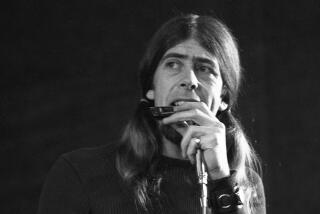Finally, a lot of Hooker in one place
As one of the most respected figures in the history of the blues, John Lee Hooker should have been an early giant of rock ‘n’ roll, right? His “Boogie Chillen’ ” was a smash R&B; single in 1949 -- just about the time Elvis Presley and the other rock pioneers were starting to turn to R&B; to help shape their musical styles.
The Mississippi native followed “Boogie Chillen’ ” two years later with another massive R&B; hit, “I’m in the Mood,” that too should have caught the ears of young rock rebels. This wasn’t a record with the polite strains of “I’m in the Mood for Love,” the pop tune from the 1930s. Hooker’s record was earthy, insistent, sexy, hard-core blues that would eventually be a cornerstone of rock ‘n’ roll.
Still, Hooker wouldn’t enjoy the kind of mainstream pop-rock popularity in the late ‘50s as such other early R&B; stars as Chuck Berry, Fats Domino and Little Richard. In fact, he wouldn’t have a Top 100 pop single until 1962, when his infectious “Boom, Boom” was simply too vital a record for rock fans to resist.
What took so long for this blues master to connect with young America?
One problem was that he was too old to fit into the youth-minded sensibilities of the mid- and late 1950s. Hooker was almost 40 when 21-year-old Presley hit the charts in 1956 with “Heartbreak Hotel.” Hooker too didn’t tailor his music to the young rock audience the way so many R&B; artists did. Like such other blues greats as Howlin’ Wolf and Muddy Waters, Hooker always sounded like an adult.
Rather than daydream about winning the heart of a high school cutie, he warned men in a 1951 recording to stop fooling around with his wife. In “Leave My Wife Alone,” he declares menacingly, “Hey man!
But if Hooker’s menacing, lustful tales were too stark and intimidating for ‘50s teens, they helped inspire the second wave of rockers, especially those from Britain, to move rock from the teen celebration of the ‘50s to the more mature themes of the ‘60s.
Before he died of natural causes at age 83 in 2001, Hooker received numerous honors, including membership in the Rock and Roll Hall of Fame and a lifetime achievement award from the Grammys. Still, Hooker’s work has never been brought together in a satisfying retrospective -- until “Hooker,” a four-disc set released today by Shout! Factory.
One reason is that he recorded for so many labels -- sometimes under such noms de plume as John Lee Cooker and Texas Slim -- that the task of licensing the material was apparently daunting. But Shout! Factory took the time to do it right.
*
John Lee Hooker
“Hooker” (Shout! Factory)
Hooker was a forceful and memorable singer and guitarist, but his signature contribution to rock was his raw, uncompromising sound. His emphasis on real-life woes of the blues helped a generation of musicians, including the Rolling Stones, move from rock adolescence to adulthood. I’ve always thought “Midnight Rambler” should be subtitled “With Appreciation to John Lee Hooker.” No one admired him more over the years than musicians. Where you often get the feeling that young musicians look at duets with veteran artists chiefly as career opportunities, it’s easy to imagine Eric Clapton, Van Morrison, Bonnie Raitt and Pete Townshend standing in line for the chance to step on stage or in the studio with Hooker. (They all duet with Hooker on tracks in this set.)
Compiled by Shawn Amos and Patrick Milligan with the cooperation of Hooker’s daughter, Zakiya, and others, this boxed set is a revelation for anyone who has heard Hooker only piecemeal. In the collection, the immensely talented singer-guitarist-songwriter finally gets the respect and showcase he has long deserved.
*
Various Artists
“Friends of Old Time Music” (Smithsonian Folkways)
Here’s another valuable salute to some folk, country and blues musicians who were largely unnoticed by ‘50s teens but went on to be major influences on the folk movement of the ‘60s that, through Bob Dylan and others, helped introduce commentary and character to rock ‘n’ roll.
In a 2001 interview with Rolling Stone magazine, Dylan spoke about his early days in New York City when he was honing his craft, “You heard records where you could, but mostly you heard other performers. You could hear the actual people singing those ballads. You could hear Clarence Ashley, Doc Watson, Dock Boggs.”
Most likely Dylan first heard those three live -- and such other remarkable “old time” music figures as Bill Monroe, Jesse Fuller, Maybelle Carter, Roscoe Holcomb and the Stanley Brothers -- at concerts sponsored in New York by an organization called the Friends of Old Time Music. The tracks in this three-disc set are taken from performances sponsored by the group from 1961 to 1965, and they carry the same glorious ring of history of Harry Smith’s “Anthology of American Folk Music,” the landmark collection of 84 traditional recordings from the 1920s and ‘30s that also had a huge effect on the ‘60s folk scene. It too is available on Smithsonian Folkways.
*
Backtracking, a biweekly feature, highlights CD reissues with special attention to artists or albums deserving of greater attention than they received originally.
More to Read
The biggest entertainment stories
Get our big stories about Hollywood, film, television, music, arts, culture and more right in your inbox as soon as they publish.
You may occasionally receive promotional content from the Los Angeles Times.










